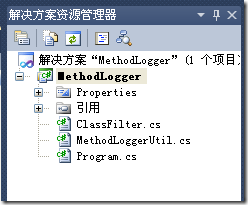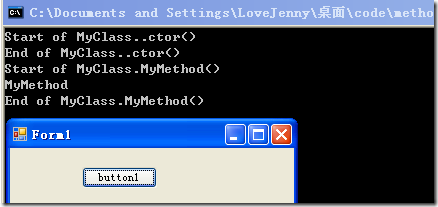如果你想记录一个方法的开始和结束,那么该怎么做呢?
最简单的方法:
public class MyClass
{
public void MyMethod()
{
Log.EnterMethod();
Console.WriteLine("MyMethod");
Log.ExitMethod();
}
}
可是,如果已经有了一个程序集,想在每个方法的开始和结束记录方法的执行,那么该如何做呢?
在CodeProject 上有篇文章就介绍了如何处理这种情况:
MethodLogger - Hook into method calls in .NET binaries
本文不打算做翻译,只是随便介绍下:How to hook into a method.
打开原文的project:

TestAppLib 主要是注入的方法:
namespace TestAppLib
{
public class MethodExecutionLogger
{
public static void MethodStarted(string typeName, string methodName, string args)
{
Console.WriteLine("Start of" + typeName + "." + methodName + "(" + args + ")");
}
public static void MethodCompleted(string typeName, string methodName, string args)
{
Console.WriteLine("End of" + typeName + "." + methodName + "(" + args + ")");
}
}
}
可以看到主要是记录typeName,methodName,args,当然如果你记录了时间的话,那么做为性能分析也未尝不可.
原文有一个缺陷,就是Winform程序使用console,如果想要看到控制台消息的话,那么应该修改下:

运行程序,点击按钮可以看到效果:

打开src里面的项目

,修改命令行参数:

其中路径可能需要修改下自己的TestApp.exe对应的路径:
运行后,再次运行TestApp.exe,可以看到结果如下:

MyClass,MyMethod 的IL如下:

 MyClass.MyMethod.method public hidebysig instance void MyMethod() cil managed
{
// 代码大小 53 (0x35)
.maxstack 3
IL_0000: ldstr "MyClass"
IL_0005: ldstr "MyMethod"
IL_000a: ldstr ""
IL_000f: call void [TestAppLib]TestAppLib.MethodExecutionLogger::MethodStarted(string,
string,
string)
.try
{
IL_0014: nop
IL_0015: ldstr "MyMethod"
IL_001a: call void [mscorlib]System.Console::WriteLine(string)
IL_001f: nop
} // end .try
finally
{
IL_0020: ldstr "MyClass"
IL_0025: ldstr "MyMethod"
IL_002a: ldstr ""
IL_002f: call void [TestAppLib]TestAppLib.MethodExecutionLogger::MethodCompleted(string,
string,
string)
} // end handler
IL_0034: ret
} // end of method MyClass::MyMethod
MyClass.MyMethod.method public hidebysig instance void MyMethod() cil managed
{
// 代码大小 53 (0x35)
.maxstack 3
IL_0000: ldstr "MyClass"
IL_0005: ldstr "MyMethod"
IL_000a: ldstr ""
IL_000f: call void [TestAppLib]TestAppLib.MethodExecutionLogger::MethodStarted(string,
string,
string)
.try
{
IL_0014: nop
IL_0015: ldstr "MyMethod"
IL_001a: call void [mscorlib]System.Console::WriteLine(string)
IL_001f: nop
} // end .try
finally
{
IL_0020: ldstr "MyClass"
IL_0025: ldstr "MyMethod"
IL_002a: ldstr ""
IL_002f: call void [TestAppLib]TestAppLib.MethodExecutionLogger::MethodCompleted(string,
string,
string)
} // end handler
IL_0034: ret
} // end of method MyClass::MyMethod
有的同学觉得很神奇,其实这也比较简单,这就是所谓的元数据编程?,通过修改IL 来实现一些特殊的需要。
通过上面的IL可以看到,MethodLogger 通过修改IL的方式实现了方法的注入。
作者使用的修改IL的库是:PERWAPI (PE Read Write API)
最主要的一个方法是这个方法:

 ModifyCode static void ModifyCode(ClassDef classDef, MethodDef methodDef, Method startLogMethod, Method endLogMethod)
{
string classNameString = MethodLoggerUtil.GetQualifiedClassName(classDef);
string methodNameString = methodDef.Name();
string paramsString = MethodLoggerUtil.GetParamsAsString(methodDef.GetParams());
Param[] parms = methodDef.GetParams();
// We'll be pushing typeName, methodName and parameters as string parameters, so set max stack size to 3.
if (methodDef.GetMaxStack() < 3)
{
methodDef.SetMaxStack(3);
}
CILInstructions instructions = methodDef.GetCodeBuffer();
instructions.StartInsert();
instructions.ldstr(classNameString);
instructions.ldstr(methodNameString);
instructions.ldstr(paramsString);
instructions.MethInst(MethodOp.call, startLogMethod);
instructions.StartBlock();
instructions.EndInsert();
while (instructions.GetNextInstruction().GetPos() < instructions.NumInstructions() - 2) ;
instructions.StartInsert();
TryBlock tryBlock = instructions.EndTryBlock();
instructions.StartBlock();
instructions.ldstr(classNameString);
instructions.ldstr(methodNameString);
instructions.ldstr(paramsString);
instructions.MethInst(MethodOp.call, endLogMethod);
instructions.EndFinallyBlock(tryBlock);
instructions.EndInsert();
}
ModifyCode static void ModifyCode(ClassDef classDef, MethodDef methodDef, Method startLogMethod, Method endLogMethod)
{
string classNameString = MethodLoggerUtil.GetQualifiedClassName(classDef);
string methodNameString = methodDef.Name();
string paramsString = MethodLoggerUtil.GetParamsAsString(methodDef.GetParams());
Param[] parms = methodDef.GetParams();
// We'll be pushing typeName, methodName and parameters as string parameters, so set max stack size to 3.
if (methodDef.GetMaxStack() < 3)
{
methodDef.SetMaxStack(3);
}
CILInstructions instructions = methodDef.GetCodeBuffer();
instructions.StartInsert();
instructions.ldstr(classNameString);
instructions.ldstr(methodNameString);
instructions.ldstr(paramsString);
instructions.MethInst(MethodOp.call, startLogMethod);
instructions.StartBlock();
instructions.EndInsert();
while (instructions.GetNextInstruction().GetPos() < instructions.NumInstructions() - 2) ;
instructions.StartInsert();
TryBlock tryBlock = instructions.EndTryBlock();
instructions.StartBlock();
instructions.ldstr(classNameString);
instructions.ldstr(methodNameString);
instructions.ldstr(paramsString);
instructions.MethInst(MethodOp.call, endLogMethod);
instructions.EndFinallyBlock(tryBlock);
instructions.EndInsert();
}
主要也是使用PERWAPI 来读写IL,然后在每个方法中写如BeginMethod和EndMethod。
修改后的MyClass.MyMethod() 大致是这个样子的:

个人建议:如果可以用第一种方法的话,就使用第一种方法,后面的修改IL的方式在某些情况下也很有用,如果有需要的同学,可以参考原文。
methodlogger.zip
methodlogger_src.zip
my_methodlogger.zip
MyClass.MyMethod
ModifyCode










【推荐】国内首个AI IDE,深度理解中文开发场景,立即下载体验Trae
【推荐】编程新体验,更懂你的AI,立即体验豆包MarsCode编程助手
【推荐】抖音旗下AI助手豆包,你的智能百科全书,全免费不限次数
【推荐】轻量又高性能的 SSH 工具 IShell:AI 加持,快人一步
· 10年+ .NET Coder 心语,封装的思维:从隐藏、稳定开始理解其本质意义
· .NET Core 中如何实现缓存的预热?
· 从 HTTP 原因短语缺失研究 HTTP/2 和 HTTP/3 的设计差异
· AI与.NET技术实操系列:向量存储与相似性搜索在 .NET 中的实现
· 基于Microsoft.Extensions.AI核心库实现RAG应用
· 10年+ .NET Coder 心语 ── 封装的思维:从隐藏、稳定开始理解其本质意义
· 地球OL攻略 —— 某应届生求职总结
· 提示词工程——AI应用必不可少的技术
· Open-Sora 2.0 重磅开源!
· 周边上新:园子的第一款马克杯温暖上架